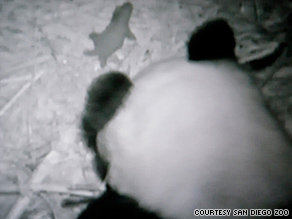
A giant panda at the San Diego Zoo gave birth to a cub the size of a stick of butter on Wednesday, her fifth cub born in the zoo since 1999.
The sex of the mostly hairless, pink newborn, which was born around 5 a.m., is not known yet, said Dr. Ron Swaisgood of the zoo’s Institute of Conservation Research. It will take about one month for the iconic black-and-white coloration of the giant panda to become visible, Swaisgood said. Its mother, Bai Yun, will care for the newborn by herself until she starts leaving the den regularly, at which time members of the zoo’s giant panda team will step in briefly to check on the cub, he said. “She is a very experienced mother. She raised all of her other cubs until about 1.5 years, the natural age for separation,” Swaisgood told CNN Radio. “She’s a real pro.” Weighing in around 300 pounds, Bai Yun is about 1,000 times the size of her cub, who weighs around 4 ounces., the typical size of a baby panda, Swaisgood said. “Pandas give birth to what’s called very ‘altricial’ cubs. That means they are very small and fragile. This cub would probably weigh about 4 ounces. It would be pink and hairless and completely dependent on the mother,” he said.
Don’t Miss
One quarter of giant panda habitat lost in Sichuan quake
Giant panda celebrates 4th birthday at National Zoo
San Diego Zoo: Panda cam
The birth is considered a success for the zoo’s Institute for Conservation Research, which works with research and breeding centers around the world to boost the endangered panda population Herself a model of that effort, Bai Yun was the first panda to be born and survive at the breeding center of the China Center for Research and Conservation of the Giant Panda in the Wolong Nature Reserve in 1991. She has given birth to four other cubs since arriving at the San Diego Zoo in 1996 from China. Two of them have since been returned to China, Swaisgood said. The newborn’s father, Gao Gao, is a wild-born giant panda that arrived at the San Diego Zoo in 2003 from the Wolong Nature Reserve. He will not be involved in raising the cub. The cub will remain in the den with its mother for a few months and gradually start to come out as soon as it is able to walk, Swaisgood said. In four to five months, the cub will be ready for the public, Swaisgood said. Until then, the public can view live video of the cub and its mother on the zoo’s Web site. “This highly endangered species still requires a lot of attention and assistance, but there is hope for the future,” he said.